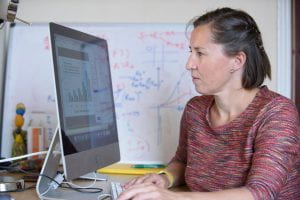
As part of our #BristolUniWomen campaign to mark International Women’s Day 2021, we’re meeting women from across the University of Bristol community who have been using their expertise to tackle the pandemic, from carrying out world-class research to helping on the frontline of the NHS.
Dr Ellen Brooks Pollock is a Senior Lecturer in Infectious Disease Mathematical Modelling, a member of the government’s SPI-M modelling group, and SAGE-subgroup on children and schools, and a member of the JUNIPER (Joint UNIversities Pandemic and Epidemiological Research) consortium.
Your research has focussed on COVID-19 recently. Could you tell us a little more?
My research involves using maths to describe how an infectious disease will spread. Before the coronavirus pandemic, I mainly worked on tuberculosis and influenza, but the underlying equations are the same for all diseases. One of my research interests is how contacts influence disease spread. Contacts depend on the disease and the host. I have worked on how cattle movements spread bovine tuberculosis, how household contacts spread human tuberculosis and how social contacts spread influenza. During the pandemic, I developed a tool for visualising the balance between social distancing and re-opening schools based on social contacts.
What have been the biggest challenges or triumphs for you during the pandemic?
It’s been really exciting to be able to contribute to SPI-M (the SAGE modelling subgroup) during the pandemic. My husband Leon is also a modeller and on SPI-M – we were first invited to SPI-M when we adapted a model of pandemic influenza to COVID-19 back in February 2020. We haven’t worked this closely before – we’ve spent many late nights coding and writing up our results after putting the kids to bed.
Some of our work last summer was widely used by SAGE and policymakers, and it was a very rewarding experience to be able to contribute to shaping policy.
What is it like being a woman in academia? Have there been times when you have either faced inequality or had to challenge it?
That is a difficult question, and it’s always hard to know if something is due to being female, either directly or because of societal norms, or whether it is par for the course. Maths and disease modelling is a fairly male dominated area, but there are prominent women as well. Rejection is a routine part of academia, but I have the feeling that women do get rejected more than men. I find it easier to see when it happens to other people: male junior scientists are more likely to be given the benefit of the doubt than female junior scientists.
Which women have inspired you in your career?
Both my PhD supervisor and postdoc supervisor are top scientists and have active family lives. Both are male – but they are great examples of doing both. I attended an inspiring talk given by Professor Dame Carol Robinson, a chemist at Oxford University. She took eight years out of science while having three kids, which proves you can take time out and still be a brilliant scientist.
What advice would you give to your 13-year-old self?
Carol Robinson said in her talk that it really helped having a supporter, and that’s definitely true. Try to work with people you like and trust and do work that you enjoy. Don’t give up!
What are you most proud of?
Hmmm… that’s a good question! I recently re-read the ‘maths careers‘ profile I wrote in 2015. In it I said my dream was to give evidence to a parliamentary select committee, which I did last year – so I’m pretty proud of that!
